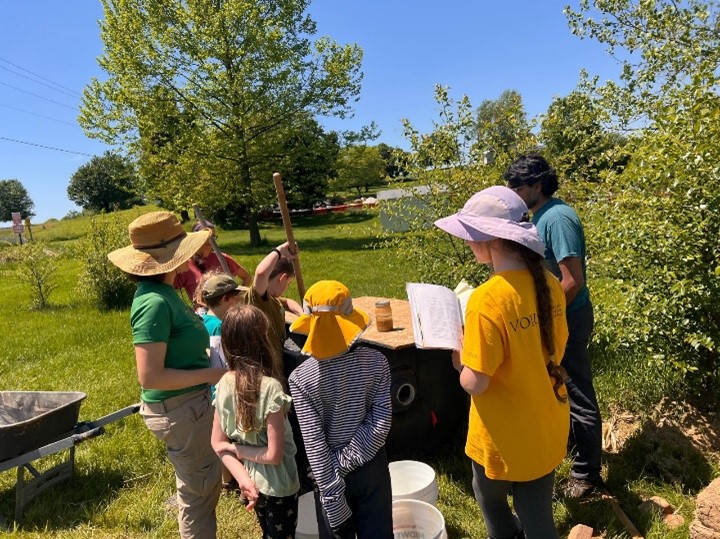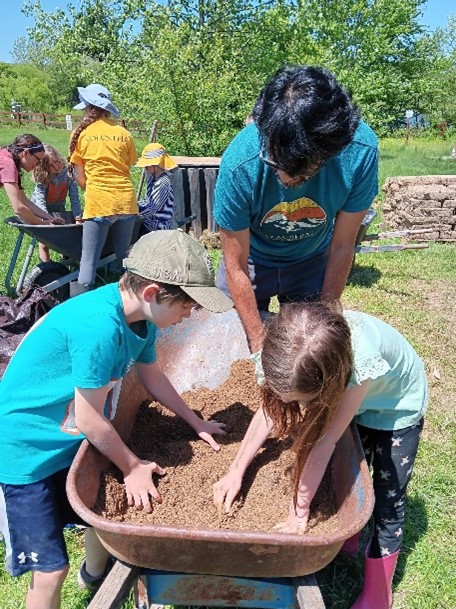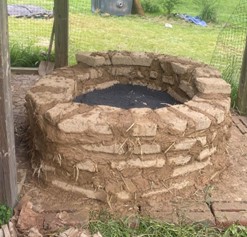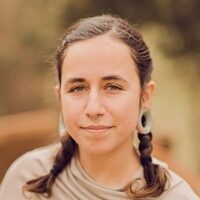Building a Cob Oven at Pearlstone
By Stephanie Katsampis, Director of Farm & Forest School
This past Spring, students in our Farm & Forest School started building a cob oven in our educational garden. They got their hands (and feet) dirty and made some amazing progress! If you’re wondering to yourself what the heck a cob oven is, don’t worry, by the end of this newsletter you’ll have some great information and perhaps even some inspiration to try this out for yourself. Let’s get started!

For over 10,000 years, people around the world have used local materials such as mud, stone, wood, grass, and straw to build their homes. As the industrial revolution and global trade made headway, the Western world began to use more concrete, metal, and glass, as they were more durable and easier to work with. In turn, a generation of specialists emerged, and owner-built homes declined—people lost touch with the knowledge and practices of the generation before them. Earthen, locally sourced building not only slowly became a foreign concept, but it also began to be seen as inferior, a product of poverty, simply because it didn’t fit in with the restructuring of social hierarchical norms. Thankfully, there is a resurgence of people looking to live in accordance and harmony with the Earth, seeking out the wisdom and their ancestors.
Now, I’m not suggesting that we forget our new ways and revert to building with mud and straw; that would undermine the genius and necessity of modern construction. I am, however, suggesting that remembering, learning, and implementing some of these ancestral building skills is a revolutionary act towards reestablishing our relationship with the Earth. When we create life-sustaining structures with the abundance the land has to offer to us, we become more grateful, confident, and rooted human beings—not to mention the wonder and awe that comes along with observing the ingenuity of nature.
Part of that ingenuity is cob. It’s believed that cob evolved from the wattle and daub technique, which uses a combination of soil, clay, sand and straw that is then ‘daubed’ over a woven lattice of wooden strips known as ‘wattle’. What’s fascinating is that remnants of this building method have been found not only in middle Europe, but also in Western Asia, North America, South America, and Africa. There’s even evidence of wattle and daub architecture showing up in Egyptian archaeological sites that date back to the 5th millennium BCE!


Building with mud isn’t exclusive to us humans though! There are many animals who use mud to build their homes such as the barn swallow or the mud dauber wasp! The barn swallow builds its nest by mixing mud and grass together to form the foundational shape, and then lines the inside with grass and feathers. The mud dauber collects mud with its mandibles, mixes it with their saliva, and then rolls it out into long, flute-like structures that they will eventually lay their larvae in.
Learning information like this can really make us wonder where our architectural ideas truly came from. Did not most of the architecture we know today evolve from what our ancestors saw around them in the ecosystem? There’s a sacred, unseen connection that exists between our modern architecture and the architecture our earth is continuously creating.
It can be relatively easy to overlook the expertise that nature demonstrates, which is why building with cob can serve as such a powerful reminder—it helps us grow in thankfulness and sparks our sense of mysterious brilliancy (or magic) in the world around us. That’s exactly what it did for us and our students in our cob building project.
For us, the process began with unlearning what we thought mud was and relearning that it comes in varying ratios of clay and aggregate. Since cob is made up of mud and straw, it means that our first step was figuring out what the contents of our soil here at Pearlstone is. To do that, our Farm & Forest School students did the “shake taste”, which is said to be one of the most accurate ways to test your soil content. We started by filling one-third of a jar with subsoil, and then added water up to the brim. We shook up the concoction and gave it time to settle. Once it did, all the aggregate had settled on the bottom of the jar, the silt/finer sand particles settled in the middle, and the clay had settled at the top.
From here we were able to evaluate the composition of our soil and see that we needed to add more aggregate to balance out our ratios, so we added in just enough sand to do that. We placed this mixture into a wheelbarrow, added water, and combined the two with our hands. From here we transferred the mixture onto a large tarp, added in straw, and this time mixed everything together using our bare feet! This was obviously everyone’s favorite part. We did this until the straw, aggregate, and clay were thoroughly mixed, and took the edges of the tarp and maneuvered it in such a way that mushed all the mixture into the center.



Our next step was building. We were fortunate enough to have access to leftover cob bricks. Our farm & stewardship team had made these bricks in 2022 for the amphitheater that’s currently being built next to our lake. We used these bricks to form the perimeter of the oven with our cob mixture serving as mortar. We placed cob down, laid a brick on top, and filled any gaps with more cob. Sometimes we would need to use a garden tool to chip away parts of the brick so that we could form the curve of the oven, which you can see in the picture to the right.

We unfortunately had to come to a stopping point, but even though our oven is unfinished and not yet making pizzas, we are so thrilled with the experience it gave to us, our students and their families. I know that when the day comes where we get to sit down together and have that first bite of pizza, it’s going to taste amazing! Not only from the fresh garden vegetables we would top it with, but from all the hard work we put into building it—with our own two hands….and feet.
So, for those who have never worked with cob before, I highly suggest giving it a try, if not for educational purposes, then at the very least for getting your hands & feet in the mud! The book Building with Cob by Adam Weismann & Katy Bryce can be a great place to start to learn more. They have everything from the history of building to step-by-step instructions and pictures.

Stephanie Katsampis is the Farm & Forest School Director and an educator at Pearlstone. Before coming to Pearlstone, Steph spent years traveling, tending the Land & studying various traditions and ways of healing. As an educator, she finds joy in weaving Cultural Wisdom and Nature-based education together in a way that allows her students tap into a greater sense of wonder, confidence, play, and sacred purpose.


